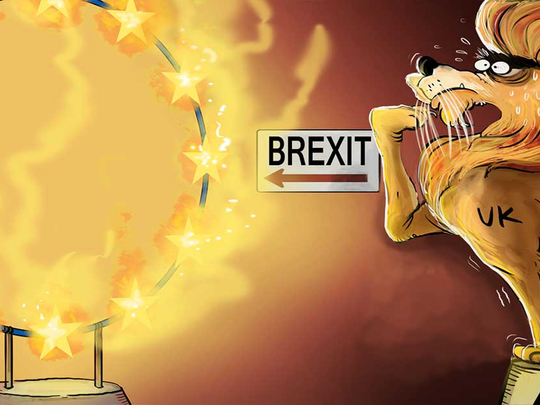
With a year until the United Kingdom is scheduled to leave the European Union (EU), Prime Minister Theresa May concluded on Friday a whirlwind tour of England, Scotland, Wales and Northern Ireland. With the nation still badly divided over its exit from the Brussels-based club, the government is moving ahead with preparations to sever ties after almost a half century of membership.
The latest big stage in this process came only last week when the European Council Summit of presidents and prime ministers signed off, in principle, on a Brexit transition deal. European leaders also agreed to their first set of draft negotiating guidelines on the future EU-UK relationship with the big ambition of securing a final Brexit framework deal that will kick-in in the 2020s after the transitional period ends.
The very limited timeframe offered by the two-year Article 50 process is exactly why the UK Government wants a transition period to help smooth Brexit and the agreement runs through to December 31, 2020, the end date of the EU’s current budget. This will help give the nation time to adjust to new political and regulatory frameworks, although some leading Brexiteers, including former UK Independence Party leader Nigel Farage, have slammed this option as pointless “backsliding” and have called for May to resign.
The transition accord, which is currently scheduled to come into effect on March 29, 2019, was finally agreed after Spain threatened to veto it over Gibraltar’s inclusion in it. Gibraltar, like the Irish border issue, remains a key area of dispute in Brexit talks and to secure Madrid’s sign off for EU leaders, who asserted that the United Kingdom must come to a bilateral agreement with Spain over the future of the UK’s overseas territory on the southern Spanish coast. Spanish Foreign Minister Alfonso Dastis has already invited the UK government to negotiations on the issue, including proposals for joint sovereignty.
The fact that Madrid may yet play hard ball in Brexit negotiations over this issue is reflected in Prime Minister Mariano Rajoy’s previous reported remarks to his UK counterpart May. He said then that such a joint sovereignty model will, under a ‘hard Brexit’ scenario of the UK leaving the European Single Market and Customs Union, be the only way for Gibraltar to secure continued access to the European Single Market which is key for its economy.
With Spain’s veto on this issue withdrawn, for now, the signing off on the transition deal now sets the stage for very tough talks on a final settlement that will be the hardest stage yet of the long negotiations process. This phase will encompass not just the parameters of a newly defined UK-EU relationship, including a new trade deal.
But they will also involve issues not fully resolved in earlier UK-EU divorce discussions, especially the future of the Irish border which remains a vexed issue with no clear solution in sight. So this is a massive task, not least as the EU Chief Brexit Negotiator Michel Barnier has said that a final framework deal should be reached by October which appears super ambitious.
What is key now in the eyes of Barnier is London giving more clarity on the UK’s final negotiating positions. The most authoritative road map here remains the Brexit set piece speech May gave in London on March 2.
May then asserted that she does not want to keep “bits of the EU”, including the Single Market and Customs Union, but would like a “bold, ambitious free trade agreement” with “the freest possible trade on goods and services”; a new customs agreement that would allow for “tariff-free trade with Europe and cross border trade that is frictionless as possible”. At the same time, she aims to take back full control of immigration policy, and move towards ending the European Court of Justice’s jurisdiction in the UK.
Even with goodwill from both sides, and the latest transition deal obstacle lifted, it is uncertain whether these collective negotiating demands can be realised from the EU, given its own tough negotiating positions, and its commitment to the four freedoms of goods, services, capital and persons. This is especially so given May’s weakened political standing after June’s UK general election where she lost her parliamentary majority.
Coming after the December 8 first phase Brexit deal, May has been temporarily strengthened by the Brexit transition agreement. However, it remains possible that her government could still fall in 2018, especially with her Conservative Party potentially enduring poor results in May’s UK local elections, which could leave her badly on the back foot again. So with a significant amount now beyond her power, even more rests on whether the remaining 27 EU states will offer outlines of such a final deal on attractive enough terms to her to accept. This is why talks could still breakdown this year, especially over the Irish border issue where London, Dublin and Brussels are still scrambling to find a solution for how a harder border can be avoided between the Republic of Ireland (which will remain in the EU) and Northern Ireland (which remains in the UK and thus leaves the Brussels-based club) without the latter remaining in a customs union with Europe, an option that May has rejected.
The economic, political and international relations stakes in play in securing a final Brexit deal are therefore big for all parties. Delivering a smooth departure will now need a high level of statesmanship and diplomatic ingenuity so that all parties can move towards a new constructive partnership for the years to come.
Andrew Hammond is an Associate at LSE IDEAS at the London School of Economics.










